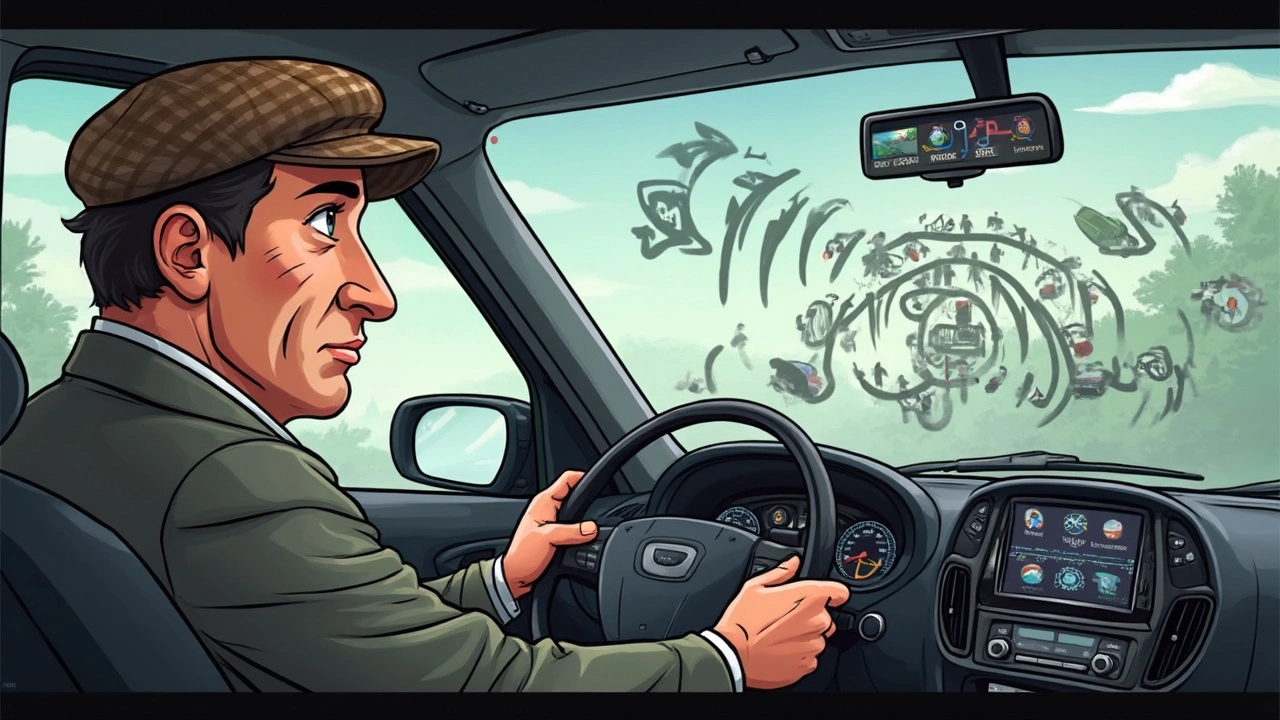Driving can be a bit tricky, especially when roundabouts come into play. So, do you signal when you're just going straight across? The answer isn't as straightforward as you might think.
Roundabouts cut down on accidents and keep traffic moving, but signaling right might seem unnecessary when you're heading straight. In many places, it's actually recommended to signal left upon exiting. Why? It shows everyone around, especially those waiting, exactly what you're up to. It's kind of like giving people a heads-up, reducing confusion, and avoiding accidents.
But here's where it gets interesting. Not everyone knows this rule, and others just forget it. It's one of those things that you might not pick up unless you dig into the local traffic laws or hear it from an instructor. Knowing these little details could really make a difference in your driving test, and more importantly, your safety.
- Understanding Roundabout Rules
- Why Signaling Matters
- Common Misconceptions
- Tips to Ace Your Driving Test
- Safety First: Practical Tips
Understanding Roundabout Rules
Roundabouts are popping up everywhere, especially here in Wellington, and understanding how to navigate them is crucial. These circular intersections aren’t just about whimsy design; they have real benefits like reducing collisions and improving traffic flow.
Basic Roundabout Navigation
In most countries, including New Zealand, you approach a roundabout and give way to the right. This means you let the traffic already in the circle have the right of way. Once there’s a clear path, you can join the movement.
Signaling: To Signal or Not?
Here's where many people get confused. When going straight through, you're usually expected to signal left as you exit. This little gesture massively helps those waiting at entry points to know your intentions, making everyone's life easier and the road safer.
- Approach: Slow down and prepare to give way to the right.
- Entry: Signal right if you're turning, or not at all if going straight when entering.
- Exit: Signal left as you exit if you haven't already signaled.
In some areas, you might notice different practices or signs, so it's always a good idea to stay adaptable and check local driving tips.
| Country | Roundabout Rules |
|---|---|
| New Zealand | Yield to the right; exit on the left signal |
| UK | Similar to New Zealand, but with varied lane rules |
| Australia | Similar signaling rules but emphasis on lane positions |
Grasping the roundabout rules isn’t just about passing your driving test. It’s about integrating smoothly into the traffic flow and contributing to safer roads for everyone. So next time you hit a roundabout, think about how your signals can communicate your actions.
Why Signaling Matters
First things first, signaling when driving isn't just about ticking boxes. It's about safety and communication on the road. Signaling ensures other drivers know what you're planning, which minimizes surprises and, importantly, reduces the risk of accidents.
Imagine sitting at a roundabout, unsure if the driver already in it is going straight or turning. Without a signal, it becomes a guessing game, sometimes with frustrating or even dangerous consequences. Proper signaling helps everyone know exactly what's going on, which keeps traffic flowing smoothly and prevents misunderstandings.
The Legal Side of Things
Most places have clear rules about roundabouts and signals. While the rules might vary a bit, the bottom line is: whatever makes your intentions more obvious is usually what the law prefers. Over 60% of driving test failures can be chalked up to not following road signals properly, including at roundabouts.
A study conducted by an Aussie traffic safety body found that clear signaling in roundabouts can reduce minor accidents by nearly 40%. Those are significant numbers when you think about it!
Building Good Habits
Learning to signal properly builds good habits early on, especially for learners prepping for their driving test. With practice, signaling becomes second nature, an automatic part of your safe-driving toolkit.
- Always signal left when you're about to exit the roundabout, even if going straight, to communicate clearly to others.
- Check the local road rules because there might be slight variations in signaling requirements!
- Practice signaling at various times and conditions to ensure you're ready for your test and everyday driving.

Common Misconceptions
Navigating roundabouts can be a breeze once you know the ropes, but there's a surprising amount of confusion around the rules. One of the biggest misunderstandings is about signaling when going straight. In some places, folks think that no signal is needed at all. Turns out, doing this can actually be misleading to other drivers.
Drivers often assume they're invisible if they're heading straight through a roundabout. However, signaling left on exit is strongly encouraged in many regions. The whole point of signaling isn't to follow a strict rule; it's to communicate with other road users, making everyone's drive smoother.
"Failing to indicate your intentions on a roundabout is one of the most common driving test pitfalls," - New Zealand Transport Agency.
This isn't just about passing your driving test. It's about making the road a safer place. Imagine pulling up to a roundabout packed with cars – all uncertain about who’s going where. Yikes! Clear signals eliminate guesswork and enhance flow, decreasing the chance of fender-benders.
Regional Differences
Different countries can have slightly different rules. For example, in the UK, the Highway Code suggests signaling right if you're taking the first exit before the roundabout. Bizarre, right? But knowing these differences is crucial, especially if you plan to drive abroad.
| Country | Roundabout Signaling Rule |
|---|---|
| New Zealand | Signal left upon exit |
| UK | Signal right before first exit, then left to leave |
Getting your head around these driving tips for different places can be a lifesaver. Local drivers might cut you some slack for being a tourist, but you’ll feel more comfortable and confident knowing you’re in the clear with the local laws. Plus, it helps avoid those awkward honks from the pros on the road!
Tips to Ace Your Driving Test
Getting ready for your driving test can feel like gearing up for a big game. You want to be prepared, confident, and sure about the rules—especially when it comes to quirky ones like signaling at roundabouts. Here’s how you can nail it.
Understand the Rules
Before anything else, dig into the nitty-gritty of local driving laws. This includes knowing when and why to signal, even when going straight. It not only helps in the test, but also keeps you safe on the road.
Practice Makes Perfect
You’ve probably heard this a million times, but practice really is your best friend. Hit the road with a friend or a driving instructor and go through real-life scenarios, like approaching roundabouts and figuring out your signaling game plan.
Stay Calm and Collected
Nerves can be a killer during tests. If you're feeling anxious, take deep breaths and remind yourself of all the practice you've put in. Calm driving is usually safer driving.
Watch Others
Ever heard of learning by doing? Try learning by seeing too. Watch other drivers, see how they navigate roundabouts, and notice if they signal when exiting. It’s like getting a free lesson every time you’re in the passenger seat.
Strategize Your Test Day
- Get a good night's sleep—no late-night cramming here.
- Eat something before the test. Being hungry can be distracting.
- Visualize a successful test without too much pressure.
- Check out the test route beforehand if possible.
With these tips, you’ll have the know-how to impress on your driving test. Remember, confidence is key; show the examiner you're sure about your driving tips and ready to tackle the road.

Safety First: Practical Tips
Navigating around a roundabout might seem daunting, but a few practical tips can make your experience much safer. Here are some straightforward guidelines:
Prepare Before You Enter
First things first, check your mirrors and know what's happening around you before you hit the roundabout. Make sure to slow down and look left. Traffic already on the circle has the right of way, so keep an eye out and be ready to stop if needed.
Signal Correctly
If you're taking the first exit, signal left as you approach. Going straight? Skip signaling until you're ready to exit, then signal left. Taking the last exit means you'll be signaling right as you approach, and don't forget to switch to left when you're about to leave the circle. These signals ensure other drivers know your intentions, reducing confusion.
- First Exit: Signal left.
- Straight: Signal left at your exit.
- Last Exit: Signal right, then left when exiting.
Stay Alert and Predictable
Always maintain a steady speed and avoid making sudden moves or stops. Stay in your lane unless you're sure you need to change. Keeping a consistent path helps other drivers predict your moves.
Avoiding Common Mistakes
A common mistake is not signaling at all, which can confuse others. Another is assuming other drivers know your next move. Always communicate clearly with signals and eye contact when necessary.
Extra Tip: Watch Out for Cyclists and Pedestrians
Cyclists and pedestrians might not be as visible as cars. Slow down near pedestrian crossings, and give cyclists lots of room. In some cases, they might even share the lane with you.
By keeping these tips in mind, you can confidently drive through roundabouts and keep the roads safer for everyone.

